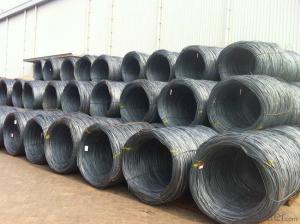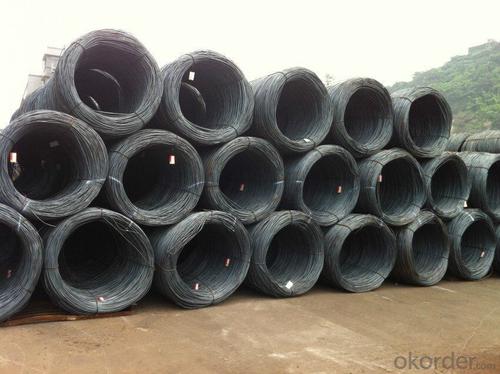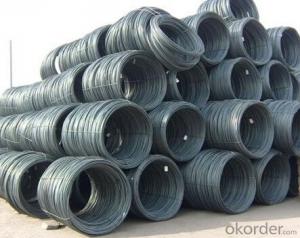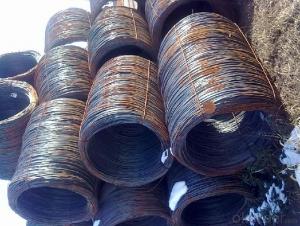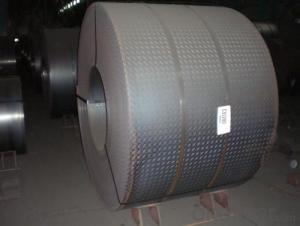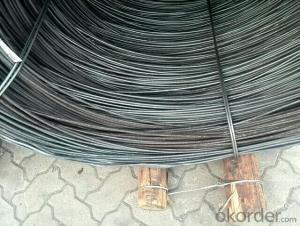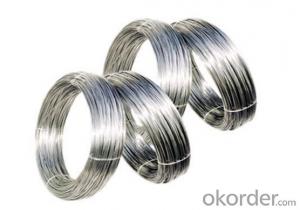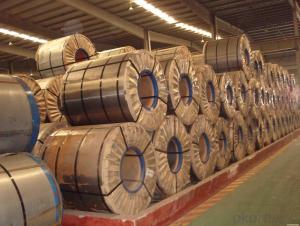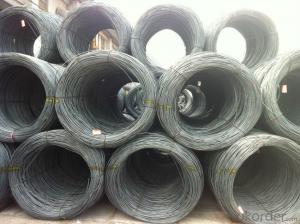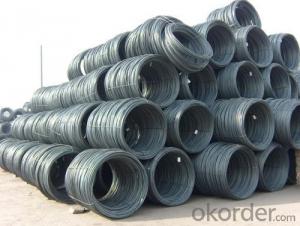Wholesale 8.5mm steel wire rod in coils from Bao Steel
- Loading Port:
- Tianjin
- Payment Terms:
- TT OR LC
- Min Order Qty:
- 25 m.t.
- Supply Capability:
- 500000 m.t./month
OKorder Service Pledge
OKorder Financial Service
You Might Also Like
Specification
Steel Grade: Q195/235, SAE1006-1018B Standard: ASTM, GB
Diameter: 5.5mm, 6.5mm, 7mm,8mm,9mm,10mm,12mm,14mm
Type: Drawn Wire Alloy or Not: Alloy Brand Name: HSKY
Technique: Hot Rolled Place of Origin: China Mainland
Chemical Composition:(Please kindly find our chemistry of our material based on SAE1006B and SAE1008B as below for your information)
High carbon/Low carbon/common carbon Steel wire rod | With boron for rebate tax |
Grade | SAE1006B SAE1008B SAE1018B |
Package | In coil ,in bundle, |
Coil weight | about 2000kg-3000kgs |
Size: | 5.5mm 6.5mm 8mm 10mm 12mm 14mm 16mm |
Types | High Carbon ,Low carbon ,Common carbon |
Exported Country | South Korea,Vietnam,Indonesia,Myanmar,Philippines and Afrca,Ect |
Delivery term: | within 30 days after receive the LC |
Payment Term: | LC at sight ,LC 30-120 days after B/L date, TT payment |
The Standard of Physical Properties:
Grade | Chemical Composition(%) | |||||
C | Mn | Si | S | P | Cr | |
SAE1006 | 0.03~O.07 | ≤0.32 | ≤0.30 | ≤0.045 | ≤0.040 | >0.30 |
Mechanical properties | ||||||
Yield strength(N/mm2) | Tensile strength(N/mm2) | Elongation(%) | ||||
250-280 | 350-380 | ≥32 | ||||
Grade | Chemical Composition(%) | |||||
C | Mn | Si | S | P | Cr | |
SAE1008 | 0.10max | 0.3~O.50 | 0.15max | 0.050max | 0.040 max | 0.30 min |
Mechanical properties | ||||||
Yield strength(N/mm2) | Tensile strength(N/mm2) | Elongation(%) | ||||
≥195 | 315-430 | ≥30 | ||||
Usage and Applications of Steel Wire Rod in Coil:
After hot-rolled the products shaped into coil and delivery as finished product, including round, square, rectangular, hexagonal and so on, Since most of the products are round, it is generally called wire rod. Steel wire rod is widely used in construction and manufacturing. Steel wire rod is mainly used for reinforcement of reinforced concrete and welded structure or reprocessed (roberts, nail etc) materials, especially used to produce wire drawing, welding electrode, nails,spring, electronic, precise machinery parts and so on.
Packaging & Delivery of Steel Wire Rod in Coil:
Packaging Detail: products are packed in coil and then shipped by container or bulk vessel
Each coil weight: 2-3MT
Delivery Detail: within 45 days after received deposit or LC.
Label: to be specified by customer, generally, each bundle has 1-2 labels
Trade terms: CFR, CIF
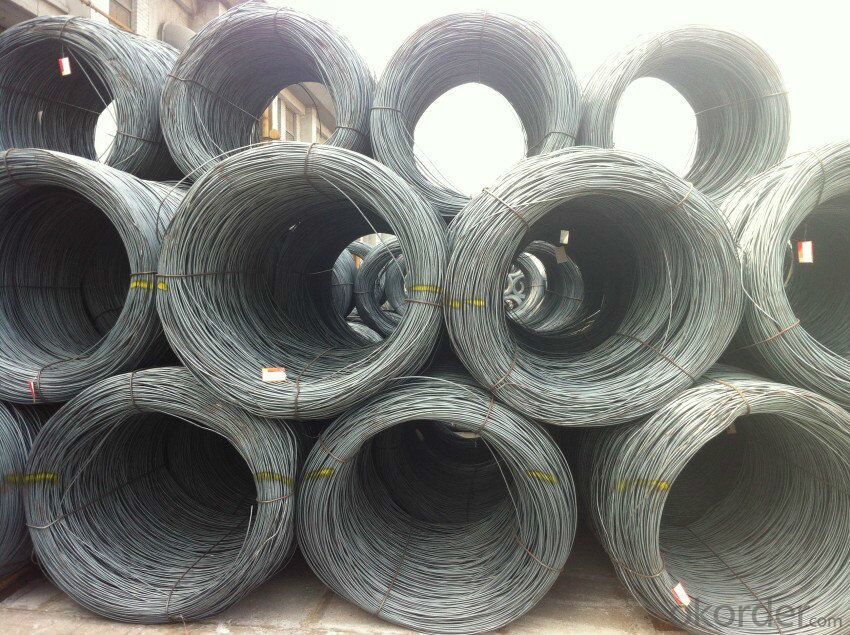
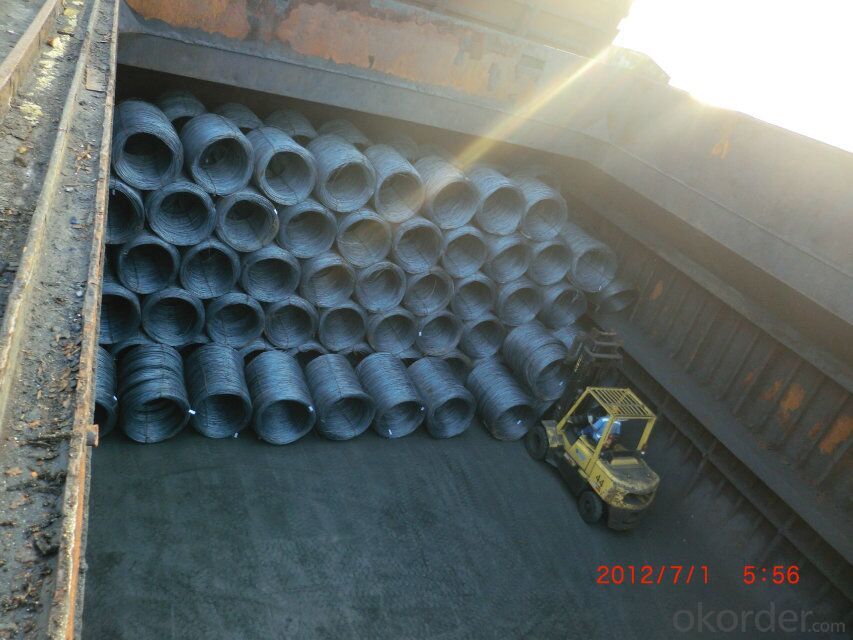
- Q: What are the major steel wire rod consuming industries?
- The major steel wire rod consuming industries include construction, automotive, manufacturing, infrastructure, and energy sectors.
- Q: What are the weight requirements for steel wire rod coils?
- Weight requirements for steel wire rod coils can differ based on the specific application and industry standards. Generally, the weight of these coils can range from a few hundred kilograms to several metric tons. Determining the exact weight requirements depends on factors like the intended use of the wire rod, the type and grade of steel used, and the transportation and handling capabilities of the facilities involved. It is crucial to refer to the relevant industry standards and specifications to guarantee compliance with weight requirements for steel wire rod coils in a specific application.
- Q: What are the common production processes for manganese-coated steel wire rod?
- The common production processes for manganese-coated steel wire rod include wire drawing, cleaning and coating. Wire drawing involves pulling the steel wire rod through a series of dies to reduce its diameter and improve its surface finish. After wire drawing, the wire rod goes through a cleaning process to remove any contaminants or scale. Finally, the wire rod is coated with a layer of manganese through a chemical or electroplating process to enhance its corrosion resistance and mechanical properties.
- Q: How is steel wire rod used in the manufacturing of wire for bicycle spokes?
- Steel wire rod is used in the manufacturing of wire for bicycle spokes by serving as the raw material. The steel wire rod is first drawn through a series of dies to reduce its diameter and increase its length, resulting in a thinner and longer wire. This wire is then further processed and shaped into the specific gauge and shape required for bicycle spokes. The strength and durability of the steel wire rod make it an ideal choice for bicycle spokes, providing the necessary support and stability to withstand the stress and strain during cycling.
- Q: How is steel wire rod straightened after the rolling process?
- Steel wire rod is straightened after the rolling process through a mechanical process known as straightening. The rod passes through a series of rotating rollers that apply pressure and tension to remove any deformities and bends, ultimately resulting in a straightened wire rod.
- Q: How is steel wire rod used in the manufacturing of wire for reinforced concrete structures?
- Steel wire rod is an essential component in the manufacturing of wire for reinforced concrete structures because it serves as the raw material for producing the wire. The rod is first drawn through a series of dies to reduce its diameter, creating the desired wire thickness. This wire is then further processed and treated to enhance its strength and durability. Finally, the wire is bundled and used to reinforce concrete structures, such as beams, columns, and slabs, providing tensile strength and improving the overall structural integrity.
- Q: What are the different types of steel wire rod surface cleaning methods after wire drawing?
- There are several different types of steel wire rod surface cleaning methods that can be employed after wire drawing to ensure the wire is free from any contaminants or impurities. 1. Mechanical Cleaning: This method involves physically removing any dirt, dust, or other particles from the wire surface using mechanical means such as brushes, air blasts, or abrasive materials. This method is effective in removing larger particles and debris. 2. Chemical Cleaning: Chemical cleaning methods use various cleaning agents or solvents to dissolve or remove any oils, grease, or other contaminants from the wire surface. These cleaning agents can be applied through spraying, immersion, or brushing, and are often followed by rinsing to ensure all residues are removed. 3. Electrolytic Cleaning: This method utilizes an electrolyte solution and an electric current to remove surface contaminants. The wire is submerged in the electrolyte solution and the electric current causes the contaminants to dissolve and separate from the wire surface. This method is effective in removing very thin layers of contaminants. 4. Pickling: Pickling is a specific type of chemical cleaning that involves immersing the wire in an acid solution to remove any oxide layers or scales that may have formed during the wire drawing process. The acid reacts with the oxides, dissolving them and leaving the wire surface clean and ready for further processing. 5. Ultrasonic Cleaning: Ultrasonic cleaning utilizes high-frequency sound waves to create tiny bubbles in a cleaning solution. These bubbles implode near the wire surface, creating a scrubbing action that helps to dislodge and remove contaminants. This method is particularly effective in cleaning wire surfaces with complex geometries or hard-to-reach areas. It is important to note that the choice of cleaning method will depend on the specific requirements of the wire application and the nature of the contaminants present. Each method has its own advantages and limitations, and it is crucial to select the most appropriate method to ensure the wire meets the desired cleanliness standards.
- Q: What are the main factors affecting the worker health in steel wire rod production?
- The main factors affecting worker health in steel wire rod production include exposure to hazardous materials such as dust, fumes, and chemicals, physical strain and repetitive movements leading to musculoskeletal disorders, noise and vibration from machinery, and the risk of accidents and injuries due to heavy equipment and high temperatures. Additionally, inadequate ventilation and poor ergonomics in the workplace can also contribute to health issues for workers in this industry.
- Q: How are steel wire rods used in the production of electrical cables for power transmission?
- Steel wire rods are indispensable in the production of electrical cables for power transmission. These rods are utilized to give the cables strength and support, ensuring their ability to endure the high voltage and mechanical strain associated with transmitting electricity over long distances. Typically crafted from high-quality carbon or alloy steel, the steel wire rods possess exceptional tensile strength and durability. These qualities make them suitable for withstanding the heavy loads and tension experienced by electrical cables during power transmission. Throughout the manufacturing process, the steel wire rods undergo wire drawing, which involves pulling them through a series of dies to reduce their diameter and increase their length. This procedure refines the steel's mechanical properties, enhances its uniformity, and allows for precise control over the wire's dimensions, guaranteeing compliance with the required specifications for power transmission cables. Once the wire rods are drawn to the desired size, they undergo further processing to create the individual strands that comprise the electrical cables. These strands are formed by twisting multiple steel wire rods together, resulting in a resilient and pliable core capable of carrying the electrical current. Following the formation of the strands, they are typically coated with insulation material such as PVC or XLPE. This insulation layer safeguards the steel wire rods from corrosion and provides electrical insulation, preventing any leakage or short-circuits during power transmission. In conclusion, steel wire rods play a vital role in the production of electrical cables for power transmission by providing the necessary strength and support to withstand the mechanical strain and high voltage involved in transmitting electricity over long distances. By incorporating steel wire rods into the cables, manufacturers can ensure the reliability and efficiency of power transmission systems.
- Q: How is steel wire rod tested for non-destructive defects?
- Steel wire rod can be tested for non-destructive defects using various methods including ultrasonic testing, magnetic particle testing, eddy current testing, and visual inspection. Ultrasonic testing involves the use of high-frequency sound waves to detect any internal flaws or defects in the rod. Magnetic particle testing uses magnetic fields and iron particles to identify surface cracks or defects. Eddy current testing utilizes electromagnetic induction to detect any surface or near-surface defects. Lastly, visual inspection involves a thorough visual examination of the wire rod to identify any visible defects or irregularities. These non-destructive testing methods ensure the quality and integrity of steel wire rod without causing any damage or destruction.
Send your message to us
Wholesale 8.5mm steel wire rod in coils from Bao Steel
- Loading Port:
- Tianjin
- Payment Terms:
- TT OR LC
- Min Order Qty:
- 25 m.t.
- Supply Capability:
- 500000 m.t./month
OKorder Service Pledge
OKorder Financial Service
Similar products
Hot products
Hot Searches
Related keywords

